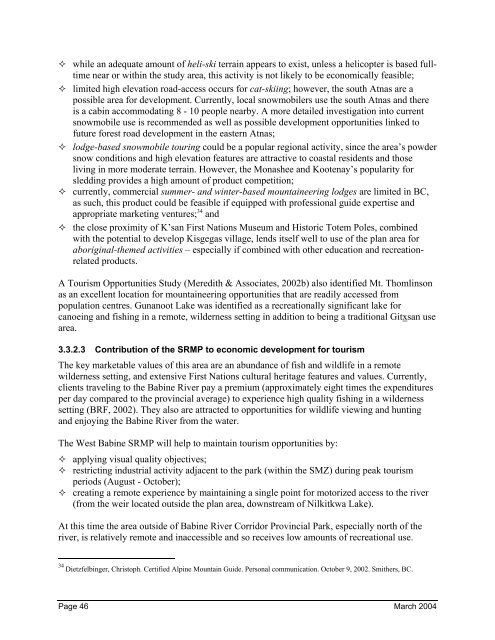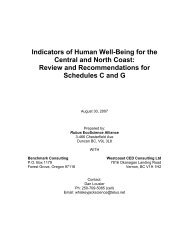West Babine Sustainable Resource Management Plan
West Babine Sustainable Resource Management Plan
West Babine Sustainable Resource Management Plan
Create successful ePaper yourself
Turn your PDF publications into a flip-book with our unique Google optimized e-Paper software.
while an adequate amount of heli-ski terrain appears to exist, unless a helicopter is based fulltime<br />
near or within the study area, this activity is not likely to be economically feasible;<br />
limited high elevation road-access occurs for cat-skiing; however, the south Atnas are a<br />
possible area for development. Currently, local snowmobilers use the south Atnas and there<br />
is a cabin accommodating 8 - 10 people nearby. A more detailed investigation into current<br />
snowmobile use is recommended as well as possible development opportunities linked to<br />
future forest road development in the eastern Atnas;<br />
lodge-based snowmobile touring could be a popular regional activity, since the area’s powder<br />
snow conditions and high elevation features are attractive to coastal residents and those<br />
living in more moderate terrain. However, the Monashee and Kootenay’s popularity for<br />
sledding provides a high amount of product competition;<br />
currently, commercial summer- and winter-based mountaineering lodges are limited in BC,<br />
as such, this product could be feasible if equipped with professional guide expertise and<br />
appropriate marketing ventures; 34 and<br />
the close proximity of K’san First Nations Museum and Historic Totem Poles, combined<br />
with the potential to develop Kisgegas village, lends itself well to use of the plan area for<br />
aboriginal-themed activities – especially if combined with other education and recreationrelated<br />
products.<br />
A Tourism Opportunities Study (Meredith & Associates, 2002b) also identified Mt. Thomlinson<br />
as an excellent location for mountaineering opportunities that are readily accessed from<br />
population centres. Gunanoot Lake was identified as a recreationally significant lake for<br />
canoeing and fishing in a remote, wilderness setting in addition to being a traditional Gitxsan use<br />
area.<br />
3.3.2.3 Contribution of the SRMP to economic development for tourism<br />
The key marketable values of this area are an abundance of fish and wildlife in a remote<br />
wilderness setting, and extensive First Nations cultural heritage features and values. Currently,<br />
clients traveling to the <strong>Babine</strong> River pay a premium (approximately eight times the expenditures<br />
per day compared to the provincial average) to experience high quality fishing in a wilderness<br />
setting (BRF, 2002). They also are attracted to opportunities for wildlife viewing and hunting<br />
and enjoying the <strong>Babine</strong> River from the water.<br />
The <strong>West</strong> <strong>Babine</strong> SRMP will help to maintain tourism opportunities by:<br />
applying visual quality objectives;<br />
restricting industrial activity adjacent to the park (within the SMZ) during peak tourism<br />
periods (August - October);<br />
creating a remote experience by maintaining a single point for motorized access to the river<br />
(from the weir located outside the plan area, downstream of Nilkitkwa Lake).<br />
At this time the area outside of <strong>Babine</strong> River Corridor Provincial Park, especially north of the<br />
river, is relatively remote and inaccessible and so receives low amounts of recreational use.<br />
34 Dietzfelbinger, Christoph. Certified Alpine Mountain Guide. Personal communication. October 9, 2002. Smithers, BC.<br />
Page 46 March 2004

















